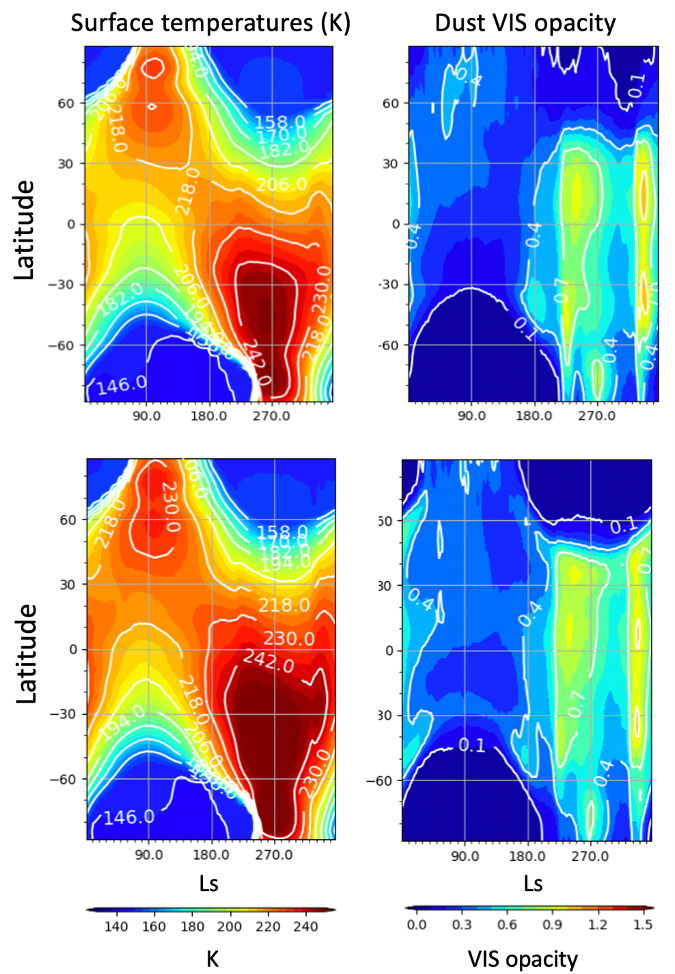Exploring the impact of bi-modal dust particle size distributions on the present-day Martian climate with the 3D NASA Ames Mars Global Climate Model
- 1LESIA, Observatoire de Paris, Université PSL, CNRS, Sorbonne Université, Université de Paris, 5 place Jules Janssen, 92195 Meudon, France (tanguy.bertrand@obspm.fr)
- 2NASA Ames Research Center, Mountain view, United States of America
- 3Space Science Institute, Boulder, CO 80301, USA
The dust cycle drives the present-day Mars climate, but many questions regarding the mechanisms of its evolution remain. In particular, despite new sets of observations for the 2018 global dust storm and new modeling efforts, climate models do not realistically capture: (1) The change in day/night surface temperatures, measured locally by REMS/MSL in Gale crater during the 2018 global storm (e.g. Montabone et al., 2020); (2) the 7 and 23-micron brightness temperatures, measured globally by the Thermal Emission Spectrometer (TES) on-board Mars Global Surveyor (MGS), and the 32-micron brightness temperatures, measured globally by the Mars Climate Sounder (MCS) on-board Mars Reconnaissance Orbiter (MRO), that depend on the actual surface temperatures and on the optical properties of dust at 7, 23 and 32 microns respectively; (3) The thermal tides, as seen in the pressure signal by REMS/MSL (Wilson et al., 2019); (4) The column dust opacities, as observed by MCS (2007, 2018 GDS) and TES (2001 GDS), with a significant degree of dispersion during the onset and decay phases of the GDSs (c.f. Fig 2, Bertrand et al., 2020); (5) The vertical dust distribution in the atmosphere, as observed by MCS during storm and non-storm conditions (Wang et al., 2018, Bertrand et al., 2020, Kleinböhl et al., 2020). These discrepancies are connected to each other and are complexly related to evolving dust particle size distributions, dust optical properties and the vertical distribution of dust.
Here we focus on the dust particle size distribution, which is challenging to realistically simulate in climate models, but which could explain some of the discrepancies above. In particular, the particle size distribution greatly influences the surface temperatures and atmospheric opacities (Bertrand et al., 2020, Wilson et al., 2019). We will employ the 3D NASA Ames Mars Global Climate Model (MGCM) to investigate the impact of dust particle sizes on the Martian climate. This model now has the capability to simulate the Martian climate with more complex dust particle size distributions lifted from the surface (with the size now evolving with time and space in the model), thus allowing multi-modal dust populations to be represented in the atmosphere that are tied to consistent radiative transfer calculations, microphysics, sedimentation, and dust coagulation. We will present MGCM simulations performed with a time and space-evolving lifted dust particle size, including bi-modal dust distributions (see Fig. 1). We will show how these processes impact the Martian climate and dust storm evolution, and compare MGCM results with observational datasets to better understand the discrepancies listed above and further constrain the dust particle sizes, sources and vertical distribution.

Figure 1: Comparison between two MGCM simulations (monomodal vs bimodal dust distribution) of present-day Mars climate. The simulations are run with only explicit dust injection (based on MCS-derived column dust opacity maps of Martian Year 33), while removal is via sedimentation and transport. Top: with a monomodal lognormal lifted dust particle size distribution having an effective radius of 2 µm. Bottom: with a bi-modal lognormal lifted dust particle size distribution having an effective radius of 1 and 3 µm (both modes correspond to 50% of the total lifted dust). Left: zonal diurnal mean surface temperatures vs time (in solar longitude). Right: zonal mean column dust VIS opacity, as simulated by the MGCM. The simulation with the bi-modal dust distribution leads to higher mean surface temperature and a slightly slower decay phase of the dust storms.
References:
Bertrand, T., Wilson, R. J., Kahre, M. A., Urata, R., & Kling, A. (2020). Simulation of the 2018 Global Dust Storm on Mars Using the NASA Ames Mars GCM: A Multitracer Approach, Journal of Geophysical Research (Planets), 125, e06122.
Heavens, N. G., Kass, D. M., Shirley, J. H (2019), Dusty Deep Convection in the Mars Year 34 Planet-Encircling Dust Event, Journal of Geophysical Research (Planets) Volume 124, Issue 11, pp. 2863-2892.
Kleinböhl, A., et al. (2020), Diurnal Variations of Dust During the 2018 Global Dust Storm Observed by the Mars Climate Sounder. Journal of Geophysical Research (Planets), Volume 125, Issue 1.
Montabone, L., Spiga, A., Kass, D. M., Kleinböhl, A., Forget, F., & Millour, E. (2020). Martian Year 34 Column Dust Climatology from Mars Climate Sounder Observations: Reconstructed Maps and Model Simulations, Journal of Geophysical Research (Planets), 125, e06111.
Spiga, A., Faure, J., Madeleine, J.-B., Määttänen, A., Forget, F. (2013), Rocket dust storms and detached dust layers in the Martian atmosphere, Journal of Geophysical Research: Planets, Volume 118, Issue 4, pp. 746-767
Wang, C., Forget, F., Bertrand, T., Spiga, A., Millour, E., & Navarro, T., 2018. Parameterization of Rocket Dust Storms on Mars in the LMD Martian GCM: Modeling Details and Validation. Journal of Geophysical Research (Planets), 123, 982.
Wilson, R. J., Bertrand, T. and Kahre, M. A. (2019), Assessing Martian Thermal Forcing from Surface Pressure Data: The MY34 Major Dust Storm, Ninth International Conference on Mars, held 22-25 July 2019 in Pasadena, California.
How to cite: Bertrand, T., Kahre, M., Urata, R., Wilson, J., Kling, A., and Wolff, M.: Exploring the impact of bi-modal dust particle size distributions on the present-day Martian climate with the 3D NASA Ames Mars Global Climate Model , Europlanet Science Congress 2021, online, 13–24 Sep 2021, EPSC2021-585, https://doi.org/10.5194/epsc2021-585, 2021.

